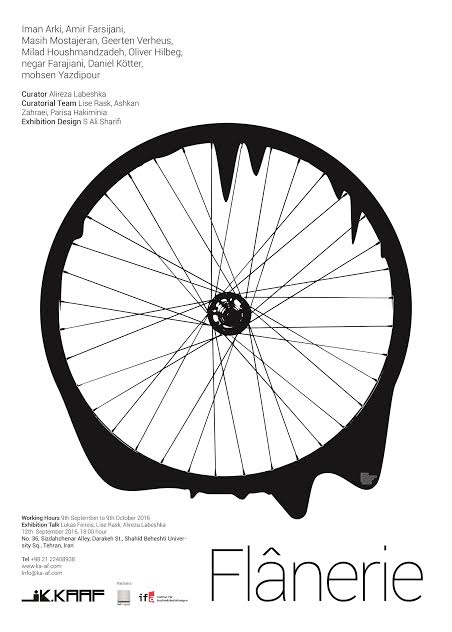
Flânerie
Flânerie is the third exhibition in a series of #UrbanHegemony project which is about the rapid urban changes in Iranian cities and the socio-political implications of these transformations. It addresses the formation processes of urban spaces that possess potential for creating new ideologies and lifestyles for citizens. The #UrbanHegemony project discusses how a city can define and subtly reconfigure the narrow borders between citizenship and non-citizenship, between order and chaos, and also between the legal and the illegal. Artists: Amir Farsijani, Mohsen Yazdipour, Masih Mostajeran, Milad Houshmandzadeh, Iman Arki, Oliver Helbig, Negar Farajiani, Geerten Verheus, Daniel Kötter Curator: Alireza Labeshka Curatorial Team: Lise Rask, Ashkan Zahraie, Parisa Hakiminia
Maybe if Walter Benjamin had escaped from Nazi Germany to today's Tehran instead of Paris, he would not only have been faced with blatant aspects of capitalism, and could have published his same Arcades Project here too, he would have also been faced with an amalgam of unbridled urban policies and again would have perhaps preferred European capitalism and his same Paris with its newly widened streets and unpolluted air to the tropical capitalism of the countries of the "Global South". For Benjamin whose "flaneur" walks freely around the city and collects his mental images from all around and even at times enjoys revelling in the world of artificial capitalist enjoyments and meanwhile recognizes the volatilities of the market in the city and traces the process of fetishism of commodities in shopping arcades and neon signs, revelling in a city in which 5000 people die each month in result of air pollution could be reminiscent of the very country from which he escaped.
In spite of sharing in the Benjaminian concept of flaneur in reification (Verdinglichung) of their mental images of the city, the Tehrani artists taking part in this exhibition have in no way benefited from the creative idleness of Parisian flâneurs while living in a city which contains 550 kilometers of urban highways, and for them Tehran is more a location for transit, and even that via private passenger vehicles, rather than a location for sauntering and interaction. With regard to this very characteristic of its being "volatile", they have portrayed today's Tehran in relation to the absence of its public spaces, and neglecting the importance of presence in the city and its outcomes with all its difficulties that have even become the theme of the works or they have presented solutions for interfering with the public scene. In contrast, the foreign artists have subconsciously taken a comparative approach to weighing up Tehran more against what goes on in other cities of the "Global South" and this comparison has at times been formed through the channel of collaged visual narratives (perhaps) in search of discovering a structure, and sometimes a symbolic language hints at the very possibility of such new/strange urban forms
شاید اگر والتر بنیامین از آلمان نازی به جای پاریس، به تهران امروز گریخته بود نه تنها با نمودهای آشکار سرمایهداری روبهرو میشد و میتوانست همان «پروژهی پاساژهایش» را اینجا نیز به طبع برساند، بلکه با ملغمهای از سیاستهای بی قید و بند شهری روبرو می شد و باز هم شاید به جای سرمایه داری حار کشورهای «جنوب جهانی»، سرمایهداری اروپایی و همان پاریس را با آن خیابانهای بهتازگی عریضشده و هوای غیرآلودهاش ترجیح میداد. برای بنیامینی که «پرسهزن»ش با فراغ بال در شهر قدم میزند و تصاویر ذهنی خود از شهر را جمعآوری میکند و حتی گاهی از رهاشدن در دنیای لذتهای مصنوعی کاپیتالیستی لذت میبرد و در عین حال نوسانهای بازار را در شهر بازشناسایی و پروسهی بتوارگی کالا را در پاساژها و نئونهای مغازهها ردیابی میکند، رهاشدن در شهری که ماهیانه فقط پنج هزار نفر از آلودگی هوا در آن جان میدهند میتوانست یادآور همان کشوری باشد که از آن گریخته است.
هنرمندان تهرانی شرکتکننده در این نمایش علیرغم اشتراکشان با مفهوم پرسهزن بنیامینی در تجسمبخشی (Verdinglichung) به تصاویر ذهنیشان از شهر، بههیچوجه از فراغت مولد پرسهزنهای پاریسی در شهری که پانصد و پنجاه کیلومتر بزرگراه درونشهری دارد برخوردار نبودهاند و تهران برای ایشان بیشتر محل گذر، آن هم با وسایل نقلیهی شخصی، بوده است تا ماندن و تعاملکردن. با توجه به همین خصیصهی «فرار»بودن، ایشان تهران امروز را در رابطه با غیاب فضاهای عمومیاش، و نادیدهانگاشتن اهمیت حضور در شهر و تبعاتاش با تمام دشواریهای ممکن که حتی گاهی موضوع خود کار شده است بهتصویر کشیدهاند و یا راهحلهایی با مداخله در عرصههای عمومی پیش کشیدهاند. در مقابل هنرمندان خارجی ناخودآگاه با رویکردی تطبیقی بیشتر تهران را با آنچه در شهرهای دیگر «جنوب جهانی» میگذرد مقایسه کردهاند و این قیاس گاه از مجرای روایتهای تصویری کلاژشده (شاید) در جستوجوی یافتن یک ساختار شکل گرفته است، و گاهی با زبانی سمبولیک اشاره به خودِ امکان چنین فرمهای بدیع/عجیب شهری صورت گرفته است.
علیرضا لبشکا

 Please wait...
Please wait...